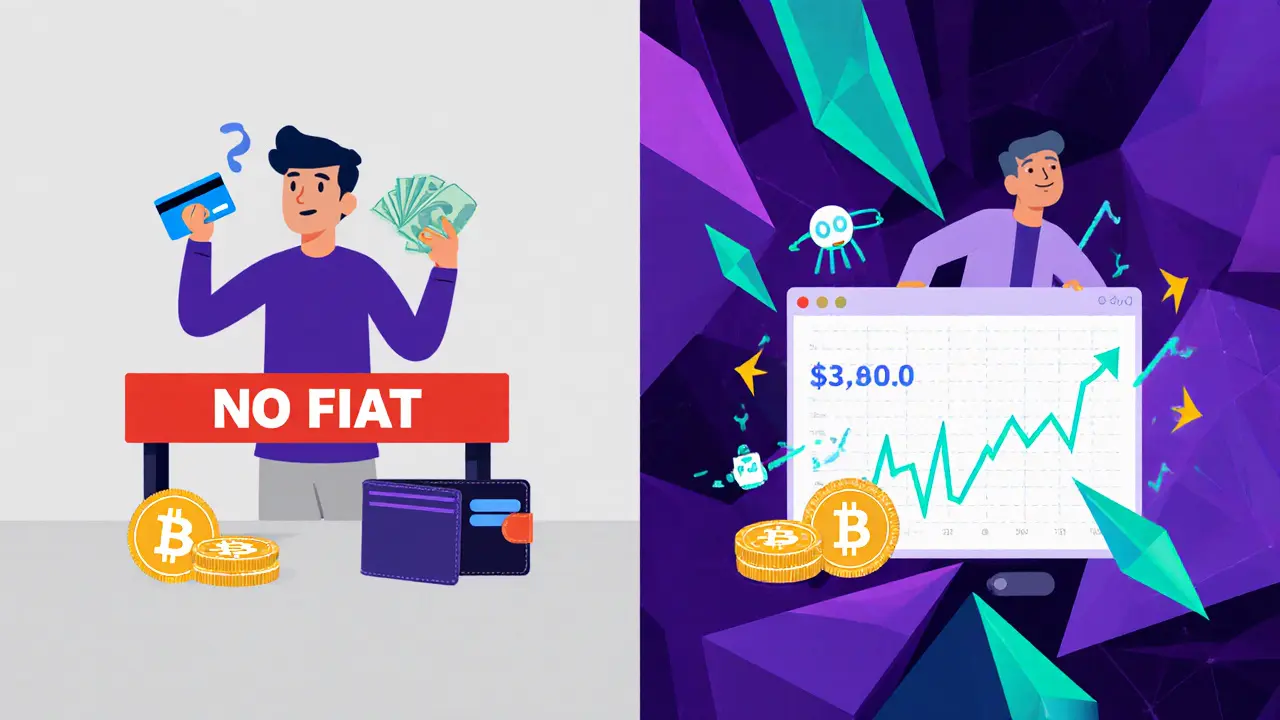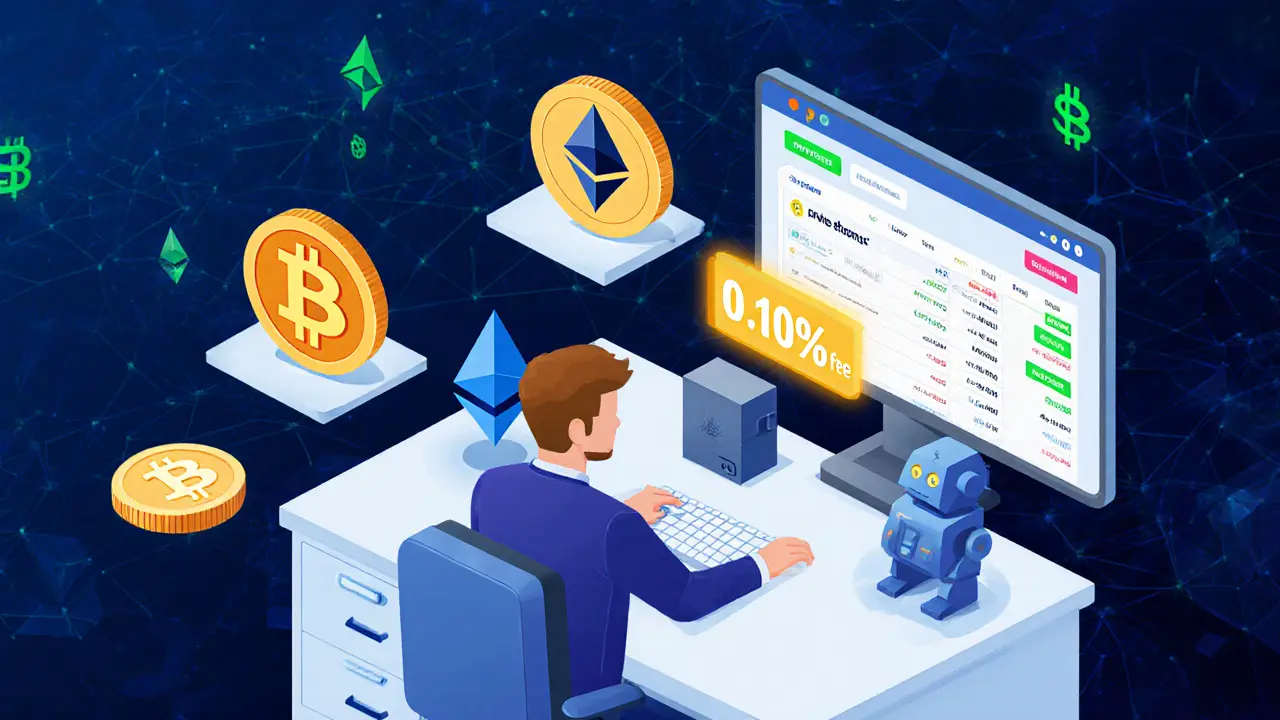Coinlim Fee Calculator
Calculate your trading savings when using Coinlim compared to Kraken and Binance US. With Coinlim's flat 0.10% fee structure, you could save significant amounts on regular trading.
Coinlim Crypto Exchange Review: Fees, Features, and Whether It's Right for You
If you're looking for a crypto exchange with rock-bottom trading fees and don't mind skipping the bank transfer step, Coinlim might catch your eye. But if you're new to crypto and still trying to figure out how to buy your first Bitcoin with a credit card, this platform isn't for you. Coinlim doesn't accept dollars, euros, or any fiat currency. You need to already own crypto to use it. That’s not a bug - it’s a design choice. And it tells you everything you need to know about who this exchange is really built for.
Founded in 2018 and based in Singapore, Coinlim isn’t trying to compete with Coinbase or Binance. It’s targeting experienced traders who already have crypto sitting on other exchanges and want to move it somewhere cheaper and more feature-packed. The platform offers tools most beginner-friendly apps don’t even dream of: arbitrage scanners, automated trading bots, demo accounts, and real-time trading signals. But none of that matters if you can’t get your money in.
Trading Fees: One of the Lowest in the Market
Coinlim’s biggest selling point is its fee structure. Both makers and takers pay a flat 0.10% per trade. That’s half the industry average of 0.25% that was standard just a few years ago. Even compared to today’s low-fee leaders like Kraken and Binance US, Coinlim still holds its ground. Kraken’s fees range from 0% to 0.4%, depending on volume. Binance US charges 0% to 0.6%. Coinlim doesn’t play games - it’s always 0.10%.
What’s even better? No hidden withdrawal fees. You pay only the blockchain network fee - the same fee you’d pay if you sent Bitcoin from your wallet to another wallet. That’s rare. Most exchanges tack on extra charges just for pulling your crypto out. Coinlim doesn’t. According to Cryptowisser’s 2025 fee analysis, the average BTC withdrawal fee across exchanges is 0.000812 BTC. Coinlim charges nothing extra on top of what the network demands. That’s a win for active traders who move funds often.
No Fiat On-Ramps: A Dealbreaker for Beginners
Here’s the catch: you can’t deposit USD, EUR, GBP, or any traditional currency. No bank transfer. No credit card. No PayPal. Nothing. If you want to start trading on Coinlim, you first have to buy crypto on another exchange - like Coinbase, Kraken, or Binance - then send it over. That adds at least 3 to 5 days to your onboarding process. You need to set up an account, verify your identity, fund it, buy crypto, wait for the deposit to clear, then transfer it to Coinlim.
This isn’t just inconvenient - it’s a major barrier. Most people who start with crypto don’t own any yet. They want to buy Bitcoin with their debit card and get started. Coinlim doesn’t let them. That’s why it doesn’t appear on any “Best Crypto Exchanges for Beginners” lists. Koinly’s 2025 ranking of top US exchanges doesn’t include Coinlim. Neither does Cryptoninjas’ list of the 10 best trading platforms. It’s not because the platform is bad - it’s because it’s not meant for newcomers.
Features That Matter to Active Traders
If you’re already trading crypto and want to level up, Coinlim has some solid tools. The platform includes:
- Automated trading bots - Set rules and let the bot execute trades for you, even when you’re asleep.
- Arbitrage tools - Spot price differences between exchanges and profit from them automatically.
- Trading signals - Get alerts based on technical indicators like RSI and MACD.
- Demo accounts - Practice strategies with fake money before risking real funds.
These aren’t gimmicks. They’re features you’d normally find on professional platforms like TradingView or 3Commas - but built into a single exchange interface. That’s rare. Most exchanges focus on buying and selling. Coinlim focuses on trading. If you’re someone who watches charts, runs backtests, or uses technical analysis, this could be your next home.

Mobile App and Interface: Functional, But Not Polished
Coinlim has native apps for both iOS and Android. That’s good. But the experience isn’t as smooth as Binance or Kraken. User reviews on Cryptogeek show an average rating of 3.9 out of 5, based on over 220 reviews. That’s lower than Changelly’s 4.4 rating (based on fewer reviews). People like the low fees and the bot features, but complain about occasional lags, confusing navigation, and slow customer support.
The interface is clean, but it assumes you already know what you’re doing. There’s no guided tour. No “How to Buy Bitcoin” tutorial. No FAQ section that explains what a maker/taker fee is. If you’ve never used a crypto exchange before, you’ll feel lost. It’s built for people who already speak the language.
Limited Language Support and Global Reach
Coinlim only supports English and Simplified Chinese. That’s it. Compare that to Changelly, which supports nine languages including Spanish, German, Russian, and Turkish. Coinlim’s focus is clearly on Asian markets and English-speaking traders who already understand crypto. If you’re in Brazil, Germany, or India and don’t read English or Chinese, you’re out of luck.
That also means customer support is likely limited to those two languages. There’s no evidence of 24/7 live chat or phone support. Most users report email responses taking 24-48 hours. For a platform that offers automated trading, that delay can be costly if something goes wrong.
Security: What We Know - and What We Don’t
Coinlim claims to use standard security practices: two-factor authentication (2FA), cold storage for most funds, and SSL encryption. But beyond that, there’s no public documentation on security audits, insurance coverage, or penetration testing. Unlike Coinbase, which discloses its SOC 2 compliance, or Kraken, which publishes regular proof-of-reserves reports, Coinlim stays quiet.
That’s not necessarily a red flag - many smaller exchanges don’t publish these details. But it’s a risk. If you’re moving large amounts of crypto, you want to know your funds are protected by third-party audits and insurance. Coinlim doesn’t offer that transparency.

Who Should Use Coinlim?
Let’s cut through the noise. Coinlim isn’t for everyone. Here’s who it’s actually good for:
- You already own crypto and want to trade it with lower fees.
- You use technical analysis and want built-in bots and signals.
- You’re comfortable with a no-fiat, crypto-only workflow.
- You’re based in Asia or speak English or Mandarin.
- You don’t need hand-holding or a beginner-friendly interface.
If you’re new to crypto, or you want to buy Bitcoin with your debit card today - skip Coinlim. Go to Coinbase or Kraken first. Once you’ve got your crypto, then consider moving it to Coinlim for cheaper, more advanced trading.
How It Compares to the Competition
Here’s a quick breakdown:
| Feature | Coinlim | Kraken | Binance US | Changelly |
|---|---|---|---|---|
| Trading Fee | 0.10% (maker & taker) | 0%-0.4% | 0%-0.6% | 0.10%-0.50% |
| Fiat Deposits | No | Yes (USD, EUR, GBP) | Yes (USD) | Yes (via partner exchanges) |
| Withdrawal Fees | None (network fees only) | Varies by coin | Varies by coin | Varies by coin |
| Trading Bots | Yes | No | No | No |
| Mobile App | Yes (iOS & Android) | Yes | Yes | Yes |
| Language Support | English, Simplified Chinese | 10+ languages | 10+ languages | 9 languages |
| User Rating (2025) | 3.9/5 (222 reviews) | 4.3/5 | 4.1/5 | 4.4/5 (57 reviews) |
Notice anything? Coinlim wins on fees and bots. But loses on accessibility, language, and trust signals. It’s a specialist tool, not a general-purpose exchange.
Final Verdict: Niche, But Powerful
Coinlim isn’t trying to be the biggest crypto exchange. It’s trying to be the cheapest and most powerful one for traders who already have crypto. If you fit that profile, it’s worth testing. The 0.10% fee alone could save you hundreds a year if you trade regularly. The bots and signals are legit tools, not marketing fluff.
But if you’re still figuring out how to buy your first Ethereum? Go somewhere else. Get your crypto on Coinbase or Kraken. Then, once you’re ready to trade like a pro, move your funds to Coinlim. That’s the smart path.
There’s no secret here. Coinlim doesn’t hide its limitations. It just doesn’t care about beginners. And that’s okay - as long as you know exactly what you’re signing up for.
Does Coinlim accept credit card deposits?
No, Coinlim does not accept credit cards, bank transfers, PayPal, or any fiat currency. You must already own cryptocurrency to use the platform. You’ll need to buy crypto on another exchange like Coinbase or Kraken first, then transfer it to Coinlim.
What are Coinlim’s trading fees?
Coinlim charges a flat 0.10% fee for both makers and takers. That’s lower than the industry average of 0.25% and competitive with top exchanges like Kraken and Binance US. There are no extra withdrawal fees - you only pay the blockchain network fee.
Is Coinlim safe to use?
Coinlim uses standard security measures like two-factor authentication and cold storage. However, it doesn’t publish third-party security audits, insurance details, or proof-of-reserves reports - unlike larger exchanges like Coinbase or Kraken. If you’re storing large amounts of crypto, consider using a hardware wallet and only keep what you’re actively trading on the exchange.
Does Coinlim have a mobile app?
Yes, Coinlim has native apps for both iOS and Android. The apps support trading, viewing your portfolio, and using bots and signals. However, user reviews suggest the interface can be clunky and slower than competitors like Binance or Kraken.
Can beginners use Coinlim?
Not easily. Coinlim assumes you already understand crypto trading, wallet addresses, and blockchain transfers. There’s no guide for buying your first Bitcoin, no fiat on-ramp, and minimal customer support for newcomers. Beginners should start with exchanges like Coinbase or Kraken before considering Coinlim.
Why isn’t Coinlim on top exchange lists?
Coinlim isn’t on lists like Koinly’s top 10 US exchanges or Cryptoninjas’ best platforms because it lacks fiat support and doesn’t target mainstream users. It’s designed for crypto-native traders, not beginners or Western retail investors. Its absence from these lists reflects its niche positioning, not necessarily poor quality.
What languages does Coinlim support?
Coinlim supports only English and Simplified Chinese. This limits its accessibility for users in Europe, Latin America, and other regions where those languages aren’t widely spoken. Competitors like Changelly support up to nine languages, making them more globally accessible.
Next Steps: Should You Try Coinlim?
If you’re already trading crypto and want to cut your fees, open a Coinlim account. Transfer a small amount - say, $100 worth of ETH or BTC - and test the bots and signals. See how fast the trades execute. See how responsive the app is. See if the interface clicks with your workflow.
If you’re still learning? Don’t rush. Buy your first crypto on a fiat-friendly exchange. Learn how to send and receive tokens. Understand what a wallet address is. Then come back to Coinlim when you’re ready to trade like a pro - not just buy and hold.
There’s no shame in starting simple. The best traders didn’t begin with advanced tools. They started with the basics - and built up from there. Coinlim isn’t the starting line. It’s the finish line for those who’ve already run the race.

Marcia Birgen
November 17, 2025 AT 01:50Jerrad Kyle
November 17, 2025 AT 21:48Usama Ahmad
November 18, 2025 AT 09:16Jess Zafarris
November 19, 2025 AT 21:56jesani amit
November 21, 2025 AT 13:18Peter Rossiter
November 22, 2025 AT 12:36Mike Gransky
November 24, 2025 AT 01:24Ella Davies
November 24, 2025 AT 19:48Nataly Soares da Mota
November 25, 2025 AT 15:19Teresa Duffy
November 26, 2025 AT 21:46Sean Pollock
November 28, 2025 AT 17:13Carol Wyss
November 29, 2025 AT 14:28Student Teacher
November 30, 2025 AT 14:12Ninad Mulay
November 30, 2025 AT 15:17Mike Calwell
December 2, 2025 AT 05:21